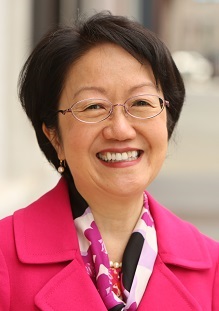Last month, Manhattan City Council Member Margaret Chin asked the de Blasio administration to prioritize affordable housing over car storage by replacing a city-owned parking garage in her district with new apartments. Acknowledging that the decision might be politically difficult, last week Chin urged her City Council colleagues to follow her lead if they want to tackle the city's affordability problem.

From Chin's op-ed in Our Town:
I understand why there’s sometimes resistance -- from officials or local stakeholders -- to certain proposals for new housing on city-owned lots that currently exist as parking garages or open space. It’s true that many of these lots already serve some purpose within our communities, and it can be difficult to commit to giving up a public resource in order to make way for housing. [...]
There’s almost always going to be some argument against giving up one of these city-owned lots. Some people might say, “Don’t take away my parking!” Others might say, “Don’t take away my green space!”
They all generally lead back to the same question: “Can’t you just find a different place for housing?”
But if we’re really serious about completing the mayor’s plan in a decade, the fact is that all of us — council members, community boards, residents — must make affordable housing a priority in our districts.
Earlier this year, Chin's office identified three city-owned lots in her district that might be suitable for new housing and asked the City Council's land use division to estimate how many new units could be built under current zoning [PDF 1, 2]. They found that a vacant lot used by a nearby business could accommodate 129 new units. Chin's office says HPD has committed to developing the property, with a request for proposals due out soon.
There were also two parking lots that could be replaced with housing: A Department of Education lot at the corner of Eldridge and Stanton Streets could house 37 families instead of approximately 30 cars, and the site of a DOT-owned public garage could offer 89 housing units instead of 356 discounted parking spaces. (Chin staffers say they have not yet heard anything back from DOT about that site, which is undergoing a $5.8 million renovation.)
Chin has an extensive background on housing issues. She helped found Asian Americans for Equality, which develops affordable housing, and used to serve on the board of the Association for Neighborhood and Housing Development. Last year, she was backed by a PAC funded by the Real Estate Board of New York but later denounced its support.
So far, it seems Chin is the only council member who's examining the potential for affordable housing on under-used city land. A freedom of information request for similar analyses produced by the City Council yielded only Chin's documents. In the meantime, the Department of Housing Preservation and Development is producing a list of city-owned property as part of the mayor's housing plan. “This is the perfect time for council members to help them get a leg up,” said Chin spokesperson Sam Spokony.
There's some momentum for parking-to-housing conversions: Last month, HPD issued an RFP for the development of affordable housing on a city-owned parking lot in Flushing. That project could replace 156 parking spaces with about 200 new housing units.
But in other neighborhoods, it might not be so easy. Bayside, for example, is looking at turning a city owned parking lot into... a parking garage. The Bayside Village Business Improvement District recently secured a $20,000 discretionary grant from Council Member Paul Vallone to study the feasibility of building a garage on an existing 92-space city-owned lot next to a Long Island Rail Road station.
The area has one of the highest car ownership rates in the city and many business owners see plentiful parking as critical to their success. "[A] person could easily hop on the Cross Island Parkway and go to Roosevelt Field, where there’s acres of free parking," said BID Executive Director Lyle Sclair. His strategy is to compete with the suburbs by emulating them. "People can say, 'I know there’s a parking garage.' It makes people more likely to come back."
Sclair doesn't see the LIRR-adjacent lot as an opportunity for transit-oriented development. “The site we’re looking at is probably not suitable for housing," he said. "It’s literally right next to the railroad station."
He noted that the completion of East Side Access will drive up demand for the Long Island Rail Road in coming years, but believes most commuters will want to park and ride. "Somebody who’s looking to Bayside is looking for more of a suburban quality," he said. "[The garage is] going to be a stimulus to bring people to the neighborhood."
In her op-ed, Chin acknowledged that turning underutilized city land into affordable housing can be a difficult proposition. "We simply can’t spend years trying to find those different places for housing that can please everyone," she wrote. "The sites are there, and we have to take advantage of them as swiftly as possible."





